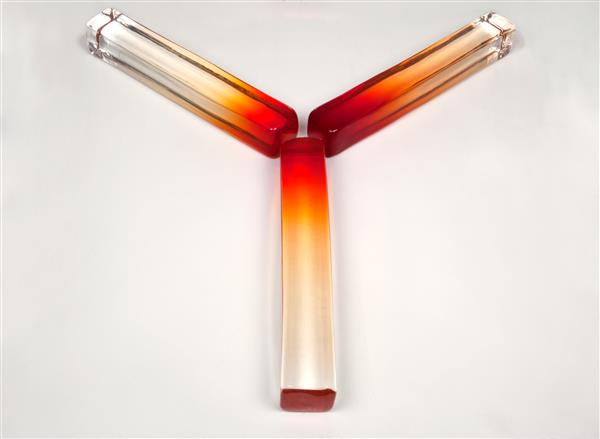Feuerstelle
Asta Gröting
glass object
3 parts, each 10.3 × 10.3 × 61.3 cm
2006
Acquisition 2007
Inv. No. 0163 abc
Works by Asta Gröting are characterized by a straightforward and stupefying literalness. What you get is what you see: Verdauungssystem eines Haies [Digestive System of a Shark] (1990) or the Space between two people having sex (2008). The artist bluntly calls her work by its name.
Feuerstelle [Fireplace] (2006) dates from a period when Asta Gröting, following a phase of intensive preoccupation with film and video, returned to her original medium, which is sculpture. She is one of those artists who direct utmost attention to form and particularly material. Feuerstelle consists of transparent Murano glass; three rods of square section are arranged on the floor like the radii of a circle, at angles of 120 degrees to one another. At the center, the glass glows in an intense red tone, speaking of heat and flames. On the one hand, the sculpture functions like a metaphor of warmth and closeness, suggesting a comforting hearth; on the other hand, it also conveys threat and danger. Fire plays an important role in the manufacturing process of glass, whereas the coldness that becomes evident here as well evokes visual associations to clanking ice.
Asta Gröting first presented Feuerstelle in 2007, together with other sculptures addressing such elementary issues of human existence as social closeness, the living organism, or nutrition. There was also Kartoffeln – a long row of potatoes in cast and polished bronze – and Acker, a human-sized piece of soil made of epoxy resin. “Soil is the primordial image of form and formation, everything that nourishes us comes from soil,” Gröting commented upon her work.
Asta Gröting’s works do not contain any confusing secrets, they seem familiar and are as self-explanatory as biological findings.1 Yet they do not amount to banal reconstructions of reality. The aspect of familiarity is exaggerated and expanded through material transfer: sculptures as intensive care units of what is well known. When put into a new context, such as a museum or an art collection, normalcy can take on an exemplary meaning and as an autonomous image may play a role on an imaginary stage. Asta Gröting calls this a “psychosocial equivalent.”
Brigitte Huck, 2011 (translation: Wolfgang Astelbauer)
1) Gerrit Gohlke, “Asta Gröting,” in: Women Artists, ed. by Uta Grosenick, Taschen, Cologne 2001, 174.
Continue readingExhibitions
Small Medium Large. Sculptures and Objects from the evn collection, evn sammlung, Maria Enzersdorf, 2022
Wallpaper #3, evn sammlung, Maria Enzersdorf, 2019
Asta Gröting, Neuer Berliner Kunstverein, Berlin, 2010
Publications
evn collection. 2006–2011, Cologne 2011, p. 156 f
